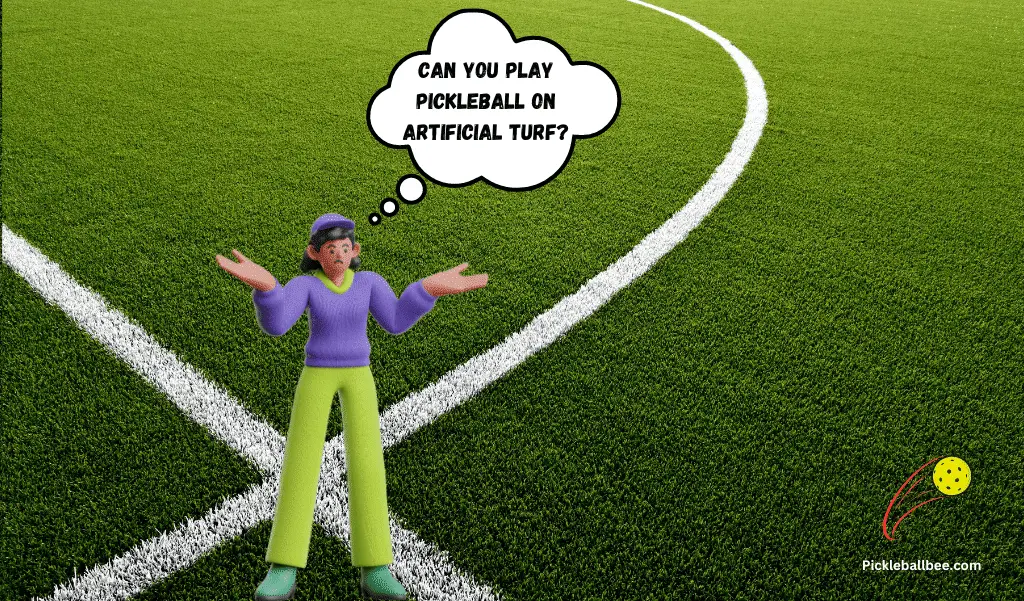
As the popularity of pickleball increases, so does the search for different playing surfaces. Artificial turf is becoming an increasingly popular choice for pickleball players as it can offer a consistent and predictable surface that stands up better to wear and tear than a natural court surface.
In this blog post, we’ll look at how pickleball performs on artificial turf, the pros and cons of using such surfaces, and more—so read on to learn all about playing pickleball on artificial turf!
What Is Artificial Turf, And How Does It Differ From Natural Turf?

Before we dive into the details of playing pickleball on artificial turf, let’s take a look at what this surface actually is. Artificial turf (also known as artificial grass or synthetic grass) is a type of flooring made from synthetic fibres designed to replicate the look and feel of natural grass. It’s often used on sports fields and other outdoor spaces where natural grass is difficult to maintain.
Unlike natural turf, artificial turf does not require mowing or irrigation and can be used all year round without weather affecting its performance. As a result, it’s becoming an increasingly popular choice for pickleball courts as it provides a durable surface that stands up to the wear and tear of regular play.
Can Pickleball Be Played On Artificial Turf?
Playing pickleball on artificial turf is not only possible but also highly recommended.

Playing pickleball on artificial turf can be an excellent choice for players looking for a consistent and predictable surface that stands up better to wear and tear than natural court surfaces. While concrete has been the traditional choice for pickleball courts.
While many pickleballers prefer the feel of outdoor hard courts, it is possible to play pickleball on artificial turf—if certain conditions are met.
When playing pickleball on artificial turf, it is important to consider the type of artificial surface that will be used. Artificial turf can come in a variety of textures and thicknesses, so the best surface for pickleball depends on the specific needs and preferences of players. For instance, some surfaces may provide more cushioning than others.
Generally speaking, however, any synthetic grass that is made of a polyethene or nylon blend and has a pile height of at least 4.5mm should be suitable for pickleball. It is also important to note that artificial turf can become quite hot in direct sunlight, so it’s best to avoid playing outdoors on particularly hot days.
What Should Not Be Put on Artificial Turf?
While artificial turf is durable and resilient, it is not suitable for all types of surfaces. Hardwood flooring, concrete and other abrasive materials should not be used on artificial turf as they can damage the surface or cause it to wear away quickly.
Chewing gum should also be avoided, as it can become embedded in the turf fibres, creating sticky patches that affect the playing surface. Adhesive substances and harsh chemicals should not be applied, as they can cause discolouration, damage, or degradation of the underlying turf materials.
Benefits of Choosing Artificial Turf Over Natural Grass for Pickleball?
Opting for artificial turf over natural grass for pickleball comes with a range of advantages. Low maintenance and long-term durability are two of the major benefits, as artificial turf requires little upkeep and can last seven to ten years or longer with proper care.
Artificial turf is also resilient against harsh weather conditions such as heavy rainfall, heat waves, and snowstorms that can damage natural grass surfaces.
Furthermore, artificial turf offers a consistent and predictable playing surface that is perfect for pickleball play. The turf has excellent shock absorption and remains level with minimal divots or bumps, which makes it ideal for the fast-paced game of pickleball. Artificial turf also provides great ball speed, spin, and control while allowing players to move across the court quickly and without difficulty.
Pros and Cons of Playing Pickleball on Artificial Turf?
playing pickleball on Artificial Turf has its pros and cons. Let’s take a look at the pros and cons of pickleball on artificial turf in more detail:

Pros:
- Artificial turf is highly durable, making it suitable for high-traffic areas such as community parks or sports complexes. The surface won’t be easily damaged and is designed to last for many years with minimal maintenance.
- Artificial turf provides a consistent surface that can be used in all weather conditions. This means the playing experience won’t be affected by rain or snow, unlike natural grass courts, which can become slippery and muddy when wet.
- The bounce of a pickleball on artificial turf is consistent, allowing players to develop their skills more easily and accurately.
Cons:
- Artificial turf can be costly to install and maintain.
- Artificial turf may not be as comfortable or forgiving on your feet and joints as natural grass courts. If you’re playing pickleball for an extended period of time, the hard surface can cause fatigue and soreness.
- The balls don’t bounce as consistently on artificial turf as they do on a natural grass court.
- Artificial turf can be hot in warmer climates, making for an uncomfortable and potentially dangerous playing surface.
Which Type of Artificial Turf is Best Suited for Playing Pickleball?
When choosing artificial turf for pickleball, there are a few important factors to consider. Not all types of artificial turf are suitable for playing pickleball, so it’s important to choose the right type in order to maximize performance and reduce long-term wear and tear.
The two main types of artificial turf used for pickleball courts are short and long-pile grass.

Short-pile grass is the most common type, as it provides good ball control and a consistent bounce, making it an ideal surface for pickleball play. It’s also more durable than longer-pile turf, meaning it will stand up better to regular use.
Longer-pile turf is becoming increasingly popular, as it provides a softer and more cushioned surface, which can reduce the impact of falls or dives. This type of artificial turf also tends to hold in heat better, meaning players won’t have to worry about cold surfaces during winter play.
When selecting artificial turf for pickleball courts, it’s important to choose a product with the right combination of ball control and cushioning. The ideal turf will provide enough grip for consistent ball control without being too hard or slippery.
Some artificial turf manufacturers offer products specifically designed for pickleball and tennis courts, with options to choose the right type of backing and infill. These types of turf are usually more expensive than generic products, but they can provide better performance as well as greater longevity.
How To Maintain And Extend The Life Of Your Artificial Turf Court?
Proper maintenance is crucial for extending the life of your artificial turf court. The following steps should be taken to ensure you get the most out of your turf:
- Mow the grass regularly and water it with a hose or sprinkler system to keep blades standing upright and avoid matting.
- Remove debris from the surface using a leaf blower or vacuum cleaner.
- Consider using a field marker to clearly define the boundaries of your court and mark out regulation lines.
- Have the turf professionally inspected at least once a year for wear and tear, as well as any signs of pest infestation or disease. This will help prevent deterioration from occurring over time.
- Apply an appropriate sealer or protector to the turf surface, such as an acrylic-based product. This will help protect the smooth surface of your court from UV damage and reduce wear and tear.
What Pickleball Should You Use on Artificial Turf?
When it comes to playing pickleball on artificial turf, the devil’s in the details, especially when choosing the right ball. Your two main options are hard plastic and rubber. Think of hard plastic balls as your reliable buddy—always there for control and durability.
Rubber balls, on the other hand, are the life of the party, adding that extra spin and power to your game. But don’t overlook size and weight; you’ll want a ball that’s between 2 1/2 to 3 1/4 inches in diameter and weighs between 0.79 to 1 ounce.
Trust me, it’s a game-changer. Both types of balls offer solid accuracy, so whether you’re going for that perfect serve or a killer smash, you’re in good hands. At the end of the day, your choice boils down to your personal style—are you all about control or do you live for the power plays? Either way, the right ball will make your game on artificial turf a total blast. So go ahead, make your pick and let the good times roll!
Conclusion:
In the end, Artificial turf can be an excellent playing surface for pickleball games and provide a consistent, predictable experience that is more durable than natural court surfaces. To ensure that your artificial turf surface stands up to wear and tear over time, it is important to regularly inspect the turf system and apply a protective sealer or protector. With regular maintenance, an artificial turf pickleball court can provide a great playing experience for years to come.
FAQ:-
Can pickleball be played on all types of artificial turf?
Yes, pickleball can be played on all types of artificial turf as long as it is properly maintained. The turf should be regularly inspected, sealed with a protective coating, and kept free of debris for optimal playability. However, it is recommended to use shorter pile heights (around ¾ to 1 inch) for the best experience.
Does playing pickleball on artificial turf require any special equipment?
Yes, pickleball players should use special outdoor turf shoes that are designed for improved traction. Additionally, it is important to check the surface of the court before playing and remove any debris or rocks that could become a tripping hazard. Finally, it is recommended to have a net system specifically designed for outdoor courts.
Can artificial turf pickleball courts be installed indoors?
Yes, it is possible to install artificial turf pickleball courts indoors. However, the surface must have sufficient drainage and adequate air circulation. Additionally, special installation techniques must be used for an indoor court that will ensure the turf maintains its integrity over time.


